Sautéed Fiddleheads Ferns
Oh Fiddleheadsticks!
Fiddlehead Ferns, Found along the Shenipsit Trail in East Hampton
May 3, 2009
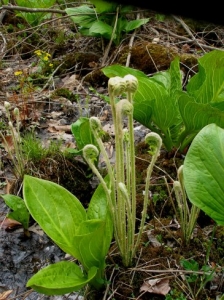 It is indeed rare to be able to talk about a unique New England edible woodland plant. Fiddleheads (actually Ostrich Ferns I think) are found in more places than the northeast, but we seem to have the market cornered (in North America) when it comes to eating them.
It is indeed rare to be able to talk about a unique New England edible woodland plant. Fiddleheads (actually Ostrich Ferns I think) are found in more places than the northeast, but we seem to have the market cornered (in North America) when it comes to eating them.
Wikipedia says: “Fiddleheads are a traditional dish of New England in the United States, and of Quebec and the Maritimes in Canada. The Canadian village of Tide Head, New Brunswick, bills itself as the Fiddlehead Capital of the World.”
Though available regionally in some supermarkets and restaurants, fiddleheads aren’t cultivated and are available only seasonally – as in, for about a 2 weeks per year. That’s why they are so expensive if you happen to see them in a Whole Foods or epicurean market. I know the Asian markets around here sell them frozen, but who wants to eat frozen ferns?
I happen to know where three particularly large groves of fiddleheads grow, along the trails I hike around the state. One patch is in Burlington and the other two down in East Hampton. If you find a patch, you’ve most likely found enough for dinner as they grow in bunches.
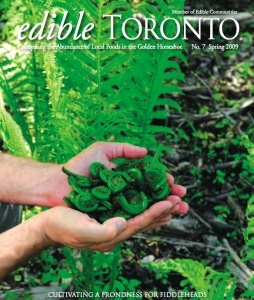

Cover model this month: Edible Toronto and Connecticut Woodlands (with a fine article from yours truly)
After a couple trips out to Burlington before they were ready, I finally hiked across a TON of them in prime picking form in East Hampton in early May. I foraged as many as would fit in my protective Coffee Cup/Ziploc thingamajing I rigged up and excitedly showed my bounty to Hoang upon arriving home.
And so, with apologies to my friend B-Side and his Adventures in Domesticity, here is my first (and probably last) fiddlehead experience.
I’d read some scary stories about mature fiddleheads being toxic and improper cooking of the good stuff yields a bitter and gritty dish. When cooking fiddleheads, first remove all the yellow/brown skin, then boil the sprouts twice with a change of water between boilings. Removing the water reduces the bitterness and the content of tannins and toxins. The Center for Disease Control associated a number of food-borne illness cases with fiddleheads in the early nineties.
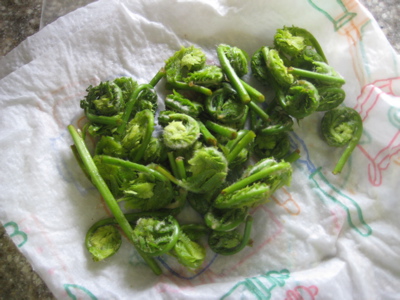
Cleaned and ready to go
Exciting! Tip: To remove the brownish papery stuff, soak them for a few minutes first. Otherwise, you’ll be there all day. I opted for the easiest and most traditional preparation.
1 pound fiddlehead ferns
2 tablespoons olive oil
Butter (optional)
2 cloves finely chopped garlic (optional)
1¼ cup pancetta or bacon, cut into 1¼ inch cubes (optional)
Kosher or sea salt and ground black pepper
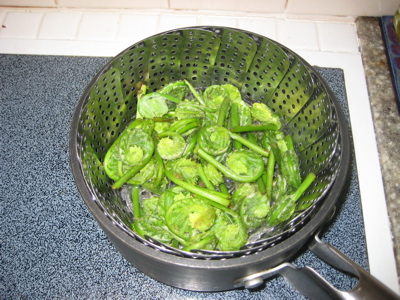
Steaming… Boiling them is for sissies
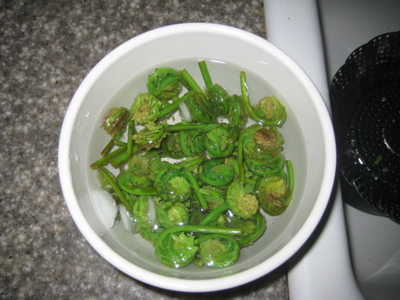
Blanch
I think I should have boiled/steamed them again at this point. Instead I just sautéed them up.
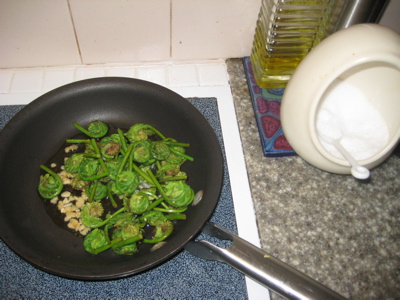
Sizzle
I called Hoang into the kitchen and we sampled.
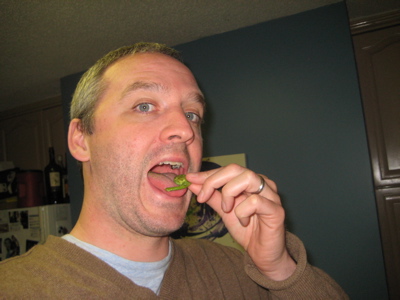
Eat
Something went wrong. They were too bitter for my taste, but again, many recipes call for double boiling and changing the tannish tannin water that results from cooking. I did neither. No matter how much butter and salt I added, they just weren’t doing it for me.
So there you have it, if not a unique Connecticut experience, a New Englandy/Maritimes one nonetheless.
…………………………………………………….






Wow, first of all I can’t believe you revealed the location of where you found the fiddleheads. That’s supposed to be a closely guarded secret. And yes, harvest only from the ostrich fern; others will make you sick. The double boil is important or, if steaming, do so for a long time (17 minutes). The trick is to cook them long enough to remove the toxins without leaving them mushy. I’ve never had them with butter. Usually I go with a simple vinaigrette so as not to overpower them (maple balsamic is nice–and seasonal).
Keep an eye out for ramps when you’re foraging next spring; they’re usually up a little earlier than fiddleheads. Fiddleheads, sauteed ramps, roasted asparagus, new potatoes, and deviled eggs–there’s no finer spring feast than that.
Comment #1 on 05.21.09 at 6:44 amAh, don’t give up on them. I have a really cool memory of my father and I eating these at a restaurant in Vermont… but the timeline in my head is either messed up or they fed us frozen fiddleheads. But, I don’t believe anyone in Vermont would have done something ridiculous like that.
Great… now, I have to call my father. Crap.
Comment #2 on 05.22.09 at 2:06 pmJust a thought about removing the bitterness. Try to soak them in very mildly salted luke warm water with a touch of baking soda in it. My gradmother taught me that with other bitter vegitables and you get the smae effect of a first boiling without boiling so the veggie doesn’t go mushy. Then I would go through with the first boil (which would now effect as the second boil) and they should be fine. Fiddleheads are one of my favorite things but I’ve only had them pickled. You’ve inspired me to give them a try for myself. Good luck and let me know if this works for you.
Comment #3 on 02.04.10 at 1:16 pmFiddleheads are a canadian delight! I grew up in CT, and have visited and hiked to many of the places on your site. As a child my parents would load us into the car once a year and we would spend the day fiddlehead picking in a remote location which i’ve never revealed. but yup, the secret is to pick them, wash them, freeze them. Boil them twice, and twice is very important. The second boil, throw in a few slices of bacon for flavor. The fiddleheads will soak that right up. Serve warm with justa bit of butter and salt. Mmmmmmmmmmmmmmmmmmmm!
Comment #4 on 09.24.10 at 3:32 pmI remember all too well skipping school to go to the islands in the Restigouche River in Tide Head and picking these little morsels. We would get 7 or 8 cents (yes 7 or 8 cents) a pound, and on a good day, you could pick 100 lbs. Not bad for a school kid in the early 60′s, when you could still buy a popsicle for a nickle, blackballs were 2 for 1 cent, and a movie, popcorn and pop cost a quarter. These islands are still covered with fiddleheads. Should be up soon I would think, although I’m far from there now. They tell me there are some in Eastern Ontario, but they are hard to find.
Comment #5 on 04.22.11 at 7:48 amFor best taste as well as for food safety, fiddleheads need to be cooked for longer than we tend to cook vegetables these days. In the old days they’d just be simmered for at least half an hour or longer. This doesn’t leave them mushy, but al dente. You don’t need to keep changing the water. Just keep cooking them longer than you think you know how to cook greens. They really don’t taste very good if they are crispy at all. You could blanch them for 15 minutes and then saute them if you must, but why bother. Do it the simple, old fashioned way, enjoy them al dente with butter, vinegar and salt, and be safe.
Comment #6 on 05.12.12 at 7:59 pm